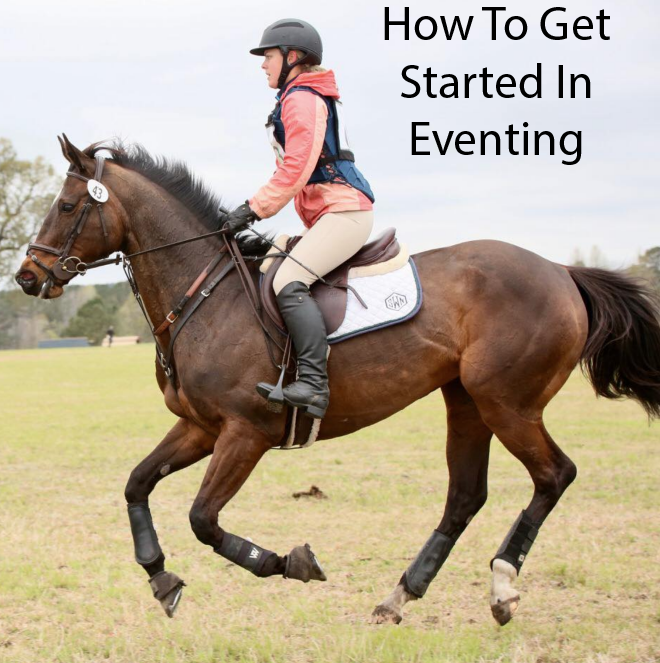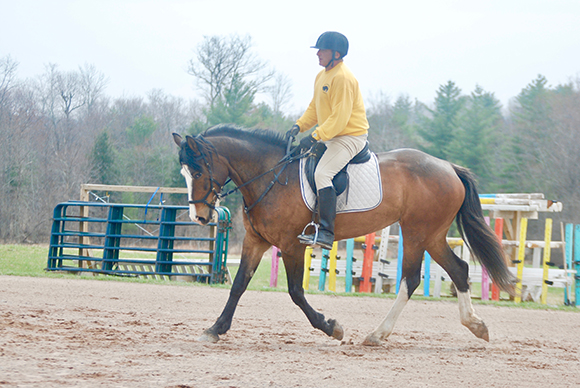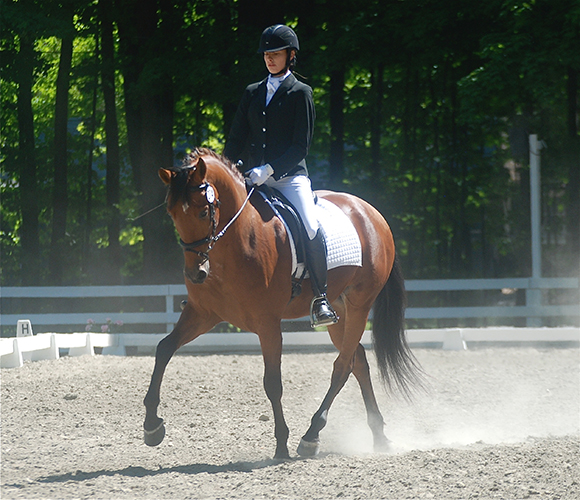How To Get Started In Eventing
By Nikki Alvin-Smith

Eventing is a combination of dressage, jumping cross-country and jumping in a stadium. This Olympic sport is full of adrenalin rushes and true excitement and is a true test of you and your horse’s fitness and athletic ability.
Before you dash off on course and kick on to those solid fences that beckon across the field, take a moment to check in and see how prepared you really are to tackle them. You need to start with the right horse and the right equipment and your job is to train your horse in three disciplines not just one. Eventing is also a test of your horsemanship, horse care and fitness and your own fitness as an athlete. None of these factors can be overlooked if you wish to be successful in this exhilarating sport.
The first discipline is dressage. This will test your horse’s suppleness and obedience, your seat, hands and ability to send your horse forward. The test will include elements of walk, trot and canter riding figures and movements in an arena. When you have a fit horse that is ready to gallop cross-country it will be a challenge to contain his energy. The dressage portion of the event is held first, and the scores here often determine the ultimate winner of the entire event. So this is a discipline you should not take lightly. To score well you should be able to ride with lightness and your horse should showcase a measure of self-carriage.
The second discipline is cross-country. This element used to include a steeplechase portion to test endurance as well as a course of solid jumping obstacles on a galloping course. The steeplechase portion has been dropped from eventing nowadays. It used to favor the thoroughbred horses to some degree and time and course management constraints ruled it off the books. The jumping portion will require more training that you might imagine. Horses will be tested jumping into shadowed wood trails which may make them stop or spook, across and into water jumps, up and down banks, over narrow fences and across variant terrain. You must know how to take a fence off stride, and how to ride bravely over a huge variety of obstacles and to stay in balance with your horse while jumping.
Interesting note: Remember horses’ can take 45 minutes to adjust their vision from bright sunlight to a dark space such as a barn or into woods from an open field, so as your horse will be totally reliant on his understanding and trust of your aids to achieve success when the light changes.
The third discipline is showjumping. You and your horse will be tired at this point in the competition and summoning the focus and energy to complete a jumping course without taking down poles will be a challenge.
The event itself will last a day, or may run over 2/3 days depending on the level of the event. In the U.S.A, there are six levels of competition. As you get up the scale the fences become higher, the courses faster and distances longer on the cross country and the number of obstacles increase. As you jump up the levels the dressage tests also become more intense, with more advanced dressage movements.
The first three levels, Beginner Novice, Novice and Training are open to riders of any age. The next level Preliminary requires a rider to be 14 or older, Intermediate and Advanced require a rider to be 16 or older.
The United States Equestrian Federation is the governing body of the sport in the U.S.A. with the F.E.I. governs the international level events.
So to get started let’s take a look at your horse for entry-level eventing. You certainly don’t need or particularly want an advanced event horse, the type you see at Badminton or Rolex level events. These types of horses would be too much for you to start out with even if you could afford one. What you do need is to have a horse that will carry you safely around an event, both on and off the course. He should be well behaved on crossties, happy to load and trailer, tack up well and stand nicely for the farrier and the vet.
For the dressage portion your horse should have three decent gaits. His walk should be free and even (sound) and he should track up. Meaning his hind foot should step ahead of the footprint of the front hoof on the same side. His trot should be regular and ground covering and his canter a good three beat. You should be able to keep him in any gait and to transition smoothly from one to the other before you entertain test riding for entry level.
The cross-country portion requires a horse to have a great attitude being ridden in open fields, through shallow water and woody trails. You horse needs to be happy to navigate rolling hills and maintain a steady canter for long distances without stress. A horse should be able to slow canter twice the distance he will be asked to do on a cross-country course. This is the level of fitness he will need for the task. It is usual to work for a mile at a steady canter, walk break and then do the same again. From a fitness point of view when this is achieved you are ready to compete. The cross country portion is timed and you do not want penalty points for being over budget and more importantly you do not want a sick horse or one that is overstressed so the training regiment for both him and also for yourself is very important.
Showjumping requires your horse to be able to jump with good form and in a safe manner. His jump should showcase no hanging or dangling front leg, he should tuck neatly in front and his knees should be higher than his elbow over a fence. Safety first! In schooling your horse must be able to maintain the same canter pace before and after a fence without rushing afterward or slowing down before.
Now to the equipment. As three disciplines are involved and tack needs to be highly adjustable at the entry level as you may be sharing tack between disciplines for budgetary needs. You won’t need three different saddles, one for each discipline at the start. A well-fitted all purpose saddle can be used across disciplines as smaller fences at the Beginner Novice level do not require extra short stirrups. A small knee roll is helpful. This saddle won’t aid you as much as a dressage saddle in position but for this level it will probably suffice.
Bridles and bits must be show legal so check with the www.usef.org website for details. You will need a snaffle bit for the dressage portion but for cross-country you may need a stronger bit. If you add a running martingale, which is recommended for jumping then be certain not to use a full cheek snaffle as the ends can become hooked with a martingale ring. You should also always use rein stops when using a martingale so the rings do not run into the bit.
A breastplate will keep your saddle in position and prevent it from slipping backwards. The strap across the neck is an added bonus as it provides a little extra security as you can grab it in a bad moment to help secure yourself in the saddle.
For your horse’s protection he should always wear protective boots. There are a multitude of types on the market. Be aware velcro closures can become useless if they become silted with sand, and a leather boot with a thick lining or the modern Equifit style D-Teq boots with impact absorption are great choices for your equine athlete. For the dressage/flat training, polos are sufficient.

It is also recommended that you use studs on your horse’s shoes. An entry level rider is more likely to have a slip on course than an experienced rider. Be sure to add bell boot protection for your horse if needed for additional protection.
For the rider the most important (and required) article of attire is the ASTM approved/certified protective headgear. For showing you will require breeches and a conservative colored show jacket for dressage and showjumping phases. For cross-country you can wear colored attire, and you must wear a protective vest in all recognized competitions. It may be a good idea to wear a protective vest in the showjumping portion too. You will need boots such plain dress boots.
Spurs, a dressage whip and jumping bat and a stopwatch are the final additions to your kit. A note on the stopwatch: Practice its use at home whenever you exercise your horse. Time your canter work, hacks etc. so that when you compete you are well used to how it works and know how to manage your time.
For training there are many details to cover to improve your ride. A key ingredient for any riding activity is to be able to stay balanced with your horse. If you can produce a good rhythm in all disciplines then you will be on top of your game because rhythm creates relaxation and jumping accuracy.
In the cross-country portion you will spend most of your time at a gallop so having a consistent 2-point position is a major advantage. You do not want to stand up in the stirrups and your position should not be too high in the saddle. During the gallop you need to absorb your horse’s movement through your ankles and knees. You do not want to open and close your hip angle as this will result in an inconsistent position.
You need to be able to see a stride when you approach the fence and there are a myriad of exercises than you can employ in training your horse to help you and your horse figure out this important facet. There are exercises that teach you to think on your feet, or rather on your horse’s hooves, exercises to teach you to lengthen and shorten the stride. All of which will be useful in the ring and out on course.
For dressage and riding in general you need to develop good hands and an independent seat. These are key areas on which to focus for all riders. Neophyte/beginner riders invariably tug on the inside rein and use it to balance. You will benefit from taking lessons on the longe line mounted on a worthy school horse with a qualified instructor to provide you with education on your balance, how to use your seat and how to move with the horse to maintain a good position. This will allow you to learn how to center and balance yourself on the horse without the use of reins and stirrups.

As you move up the levels you will specialize more and more. You may use a dressage trainer, a cross-country trainer and a showjumping trainer on a regular basis. There are also lots of ways to work on yourself without the help of a trainer and many resources to guide you are available in books/DVDs and online.
Throughout your journey you must always look to your horse for any indication of his soundness issues or ‘off’ days. Horses tell us in a myriad of ways if they are uncomfortable either physically or mentally. It is important not to overface your horse with bigger and bigger fences and demands before he has the proper understanding, ability and confidence to undertake your requests. You must acknowledge problems mounting, standing, jumping or moving forward as possible issues with saddle fit, soundness and dietary needs. Eventing is a true test of the horseman you are and can you will find out much as you go if you are observant and listen to your horse and continue to educate yourself.
Stay safe by doing your homework at home. Not at the event. If you are not ready in all three phases at home it is not going to suddenly become brilliant at a show.
Just be sure you have properly prepared for your outing and both you and your horse will enjoy the challenge. Many of our dressage clinic riders are eventers first and foremost and they enjoy working on their dressage portion. While some are advanced professionals some are just starting out in eventing. Folks of all ages attend. It is never too late to start eventing.
As a dressage rider that rode showjumpers as a teenager in England before moving to the U.S.A. and taking up dressage, I can appreciate the sincere joy of galloping and jumping horses as well as the beauty of dressage. I have shown in all three disciplines and can attest to the fact that without question, eventers are always the friendliest, most down to earth and kindest group of competitors. So don’t be shy to give it a try.
Kick on and see you at the rail.


